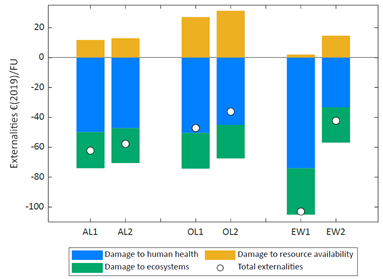The IPCC scenarios mainly focus on bioenergy with carbon capture and storage and afforestation/reforestation as Carbon Dioxide Removal (CDR) strategies. However, the conservation and restoration of marine ecosystems and other approaches such as ocean alkalinization can enhance the ocean’s natural CO2 sequestration potential. Marine NETPs are still emerging CDR strategies. Only recently, initiatives such as Project Vesta and Running Tide have launched pilot projects to assess the feasibility of CDR via coastal enhanced weathering and kelp farming and sinking.
A sustainability assessment of Marine NETPs was performed by NEGEM partner NIVA, which applied an LCA methodology to derive a set of key performance indicators (KPIs) to quantify the performance in three scenarios:
- Kelp farming and sinking
- Ocean liming
- Coastal enhanced weathering
The assessment found that all the modeled scenarios can prevent net climate change impacts in the range of 836-980 kg CO2-eq per tonne of sequestered CO2. Coastal enhanced weathering was the best-performing marine NETP in terms of climate change impacts, whilst ocean liming scenarios based on the most pessimistic assumptions attained the highest climate change impacts, mainly driven by its high energy demand for the oxy-fuel limestone calcination process.

All the scenarios can prevent externalities, which were estimated in a range between 36 and 103 € per tonne of CO2 sequestered. In the case of coastal enhanced weathering the value of the averted externalities is up to 14 times greater than the costs of the technology, which could incentivize the implementation of these NETPs. On the contrary, in the case of kelp farming and sinking the value of prevented externalities constitutes less than 5% of the kelp selling price, which could make this solution less economically competitive than other marine NETPs.
These results are subject to the uncertainty linked to data and modeling assumptions, experimental research is required to validate some of the assumptions and uncover potential side-effects not accounted for here, At the same time, the insights gained from this work could help underpin future research activities and highlight the importance of considering all the sustainability dimensions to guide future decisions. Further research should investigate the implications of countering ocean acidification with the addition of alkaline materials to the seawater, the potential methane emissions associated with macroalgae cultivation and the effects on the local biodiversity.
Read the report: Comprehensive sustainability assessment of marine NETPs
You may also like:
Comprehensive sustainability assessment of terrestrial biodiversity NETPs


